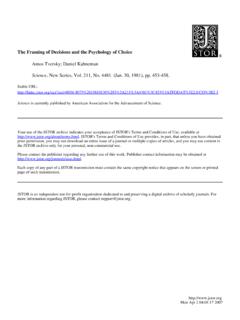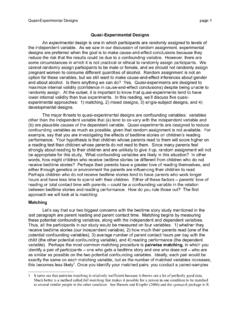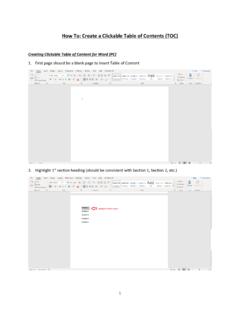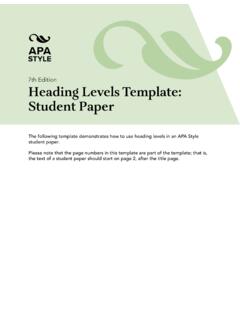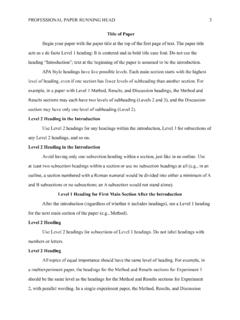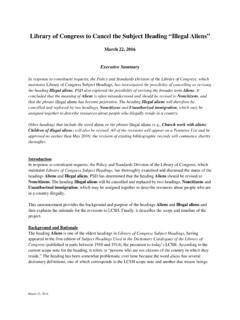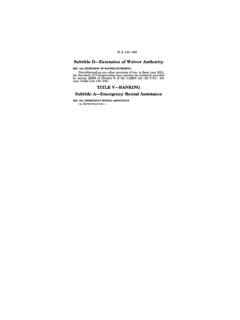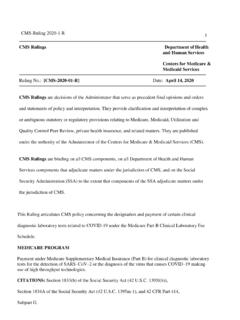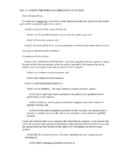Transcription of The Method Section page 1 - Hanover College
1 The Method Sectionpage 1 Method SectionThe Method Section comes after the title page, abstract, and introduction, but we discuss it before all of those because it is the only Section you have enough information to write about before you collect your data. The Method Section is the Section in which you describe the details of how your study was conducted. You haven t conducted your study yet, but go ahead and write in the past tense because that is the tense you will eventually need ( , Participants completed a ). How Much Detail?You should provide sufficient detail so that your study could be replicated in all its essential characteristics. However, you should omit aspects of the study that are unlikely to be important to the outcome: exact room temperature, color of the room, or details about the furniture can be omitted (assuming they are not independent variables).
2 In addition, you should not repeat information that was presented in another Section . If you describe the questionnaire in the Materials subsection, do not also describe it in the Procedure Advice on StyleLabels. Come up with labels for your independent and dependent variables and the levels of the independent variable that are easy to use and understand. DO NOT refer to the two levels of your independent variable as Group A and Group B or Group 1 and Group 2. Nobody will ever remember which one is which. Instead, call them the $1 condition and the $20 condition or the low anxiety group and the high anxiety group. Numbers. APA style requires that numbers that appear at the beginning of a sentence be spelled out: Fifty percent of the rather than 50% of the participants.
3 In addition, all numbers less than 10 should also be spelled out: .. The Method Section has three main subsections: Participants, Materials, and Procedure. Each subsection has its own heading, the formatting of which is described in the APA Publication Manual on pages 113-115 and demonstrated on page many? were they selected ( , from introductory psychology courses, acquaintances of the experimenter, etc.)? If you got participants from different sources, describe the percentage obtained from demographics information: percentage female (or male), age range and average age, and the percentage of participants belonging to various ethnic groups (include at least Caucasian, African American, Latino/a, East Asian, Indian, Native American, and other ). Note: names of ethnic groups are proper nouns and should be capitalized.
4 The proper form for using a label to describe a group of people is to use the label that is generally approved by that you did not use data from some of the participants, you must explain the rule you used to exclude the data: error rates above ___%, participant expressed suspicion, etc. You will not know these until you conduct your study. If no data was excluded, you do not have to mention : An error commonly made by beginning researchers is to state that participants were obtained randomly. Do not use the term random lightly: it implies that every member of the population had an equal probability of inclusion in your study. Unless you went to great pains to obtain a truly random sample, do not use the word random. You could say that you obtained a convenience sample, or you could simply not mention the sampling procedure you used and the reader will assume that it was a convenience Bill Altermatt, last updated 10/12/2008 The Method Sectionpage 2 MaterialsIn this Section , you should provide a description of any equipment or physical settings that were important aspects of your study.
5 If you are conducting a study that involves precise measurement, you will want to be very specific about the equipment you used. For example, if you are measuring how quickly a participant responds to a stimulus on a computer screen, you would need to describe the software you are using, important characteristics of the monitor (size, refresh rate, contrast, etc.), and distance of participants from the monitor. Do not bother describing the size of the room you used or its general layout unless these are important to the study. Questionnaires. One of the most common elements of the Materials subsection is a questionnaire. If you used a questionnaire in your study, you will want to source of the questionnaire (if it was originally created by someone else, you should cite the original source and include it in your References Section ) construct the questionnaire is designed to measure.
6 Designed to measure the degree to which people believe in government conspiracies. Note: your questionnaire is not designed to test your hypothesis, it is designed to measure a variable. For example, your questionnaire cannot directly measure whether men and women differ in their attitudes toward gun control. That s what your study might be designed to test, but the questionnaire in that study would only measure attitudes toward gun control. number of items in your to three sample items. If you are creating a new questionnaire, place the full set of items in an Appendix and refer the reader to the Appendix: (see Appendix for complete list of questionnaire items).. An Appendix would appear after the References Section but before any Figures or reliability estimates ( , Cronbach s alpha, test-retest reliability) that might be available from previous research.
7 Occasionally, researchers will put the reliability that they obtain in the present study into the Method Section rather than the Results the procedure Section , the researcher provides a step-by-step description of the participants experience. Do not describe any data analysis or other actions taken by the researcher that do not directly involve the participants themselves. Some common elements in the Procedure Section to participants. What were they told the study was about? Participants were told that the study was designed to explore the first impressions people form when they see a picture of someone. consent. Did the researcher obtain informed consent? Was any deception used? Were participants informed about the confidentiality of any sensitive information?
8 To conditions. How was this done? Were participants randomly assigned? Did you use matching? Did participants assign themselves to levels of the independent variable? manipulations. How were participants treated differently across conditions? Be careful not to duplicate information you have already presented in the Materials Section . For example, if you ve already described a high-fear video and a low-fear video, do not describe them again here. Instead, assume that the reader will remember the labels you introduced in the Materials Section and simply state that participants watched either the high-fear or the low-fear How long did the procedure take? Participants generally completed the questionnaire within 10 minutes. Were participants debriefed? Were they given a written debriefing or did the researcher conduct an oral debriefing?
9 By Bill Altermatt, last updated 10/12/2008 The Method Sectionpage This is a concise way to conclude the Procedure Section , , Participants were given a written debriefing, thanked for their participation, and were dismissed. by Bill Altermatt, last updated 10/12/2008





